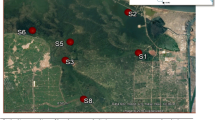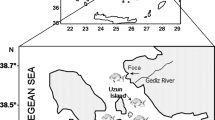Abstract
Heavy metals and organochlorine residues were determined in water, sediment, fish muscle, and freshwater shrimps from aquatic environments in urban and peri-urban areas in Morogoro, Tanzania. Most of the water samples had heavy metal concentrations below WHO acceptable water quality guidelines. All sediment samples had comparable heavy metal concentrations that suggest natural rather than anthropogenic origin. Hexachlorobenzene, α-hexachlocychlohexane, cis-chlordane, trans-nonachlordane, cis-nonachlordane, pp′-DDE, op′-DDD, pp′-DDD, op′-DDT, and pp′-DDT in hairy river prawn (Macrobrachium rude), African sharptooth catfish (Clarias gariepinus), and Wami tilapia (Oreochromis urolepis) were detected at significant concentrations above the methods’ detection limits. The ratio of pp′-DDT to ∑DDTs was 0.4 in O. urolepis and 0.3 in C. gariepinus, which indicated previous rather than current use of DDT. In M. rude, only pp′-DDE was detected and in O. urolepis and C. gariepinus there were higher levels of pp′-DDE than pp′-DDT, which demonstrate uptake of pp′-DDE, rather than pp′-DDT, from the environment. Bioaccumulation of organochlorines and mercury was the highest in C. gariepinus, cadmium in M. rude, and lead in both M. rude and O. urolepis. Maximum detected levels of organochlorine pesticides and heavy metals in M. rude, O. urolepis, and C. gariepinus were below the maximum permissible concentrations recommended by FAO/WHO. It is concluded that, at present, the contribution of anthropogenic sources in pollution of aquatic environments in Morogoro urban and peri-urban areas are low and that the concentrations of heavy metals and organochlorine pesticides in water and fish do not indicate a risk to the consumers.



Similar content being viewed by others
References
ANZ. (2000). Sediment quality guidelines. In: Australian and New Zealand Guidelines for Fresh and Marine Water Quality. Vol 2. Aquatic Ecosystems—Rationale and Background Information. Report, pp 41.
Barron, M. (1990). Bioconcentration. Environmental Science & Technology, 24, 1612–1618. doi:10.1021/es00081a001.
Boon, J. P., Lewis, W. E., Tjoen-A-Choy, M. R., Allchin, C. R., Law, R. J., De Boer, J., et al. (2002). Levels of polybrominated diphenyl ether (PBDE) flame retardants in animals representing different trophic levels of the North Sea food Web. Environmental Science & Technology, 36, 4025–4032. doi:10.1021/es0158298.
Brevik, E. M. (1978). Gas chromatographic method for the determination of organochlorine pesticides in human milk. Bulletin of Environmental Contamination and Toxicology, 19, 281–286. doi:10.1007/BF01685799.
Bwathondi, P. O. J., Fupi, V., Nanyaro, G., Mgini, J., Manduta, M. C., Busumbiro, S., Siafu, D. K., Mhije, Z.J., Masallaand, J., & Mafie, N. Y.(1992). Investigations on the presence of heavy metals (lead and mercury) in Mindu Dam, Morogoro. Report, pp 22.
Connell, D. M., Lam, P., Richardson, B., & Wu, R. (1999). Introduction to ecotoxicology (p. 170). London: Blackwell.
Erdogrul, Ö., Covaci, A., & Schepens, P. (2005). Levels of organochlorine pesticides, polychlorinated biphenyls and brominated diphenyl ethers in fish species from Kahramanmaras, Turkey. Environment International, 31, 703–711. doi:10.1016/j.envint.2005.01.002.
Esser, H. O., & Moser, P. (1982). An appraisal of problems related to the measurement and evaluation of bioaccumulation. Ecotoxicology and Environmental Safety, 6, 131–148. doi:10.1016/0147-6513(82)90001-X.
Henry, L., & Kishimba, M. A. (2006). Pesticide levels in Nile tilapia (Oreochromis niloticus) and Nile perch (Lates niloticus) from Southern Lake Victoria, Tanzania. Environmental Pollution, 140, 348–354. doi:10.1016/j.envpol.2005.06.029.
MacDonald, D. D., Ingersoll, C. G., & Berger, T. A. (2000). Development and evaluation of consensus based sediment quality guidelines for fresh water ecosystems. Archives of Environmental Contamination and Toxicology, 39, 20–31. doi:10.1007/s002440010075.
Madete, A. E., & Enock, J.(2005). The Stockholm Convention on Persistent Organic Pollutants (POPs): Overview and Implementation Status in Tanzania. Proceedings of the Multi Stakeholder Workshop on Pesticides and Poverty. Implementing Chemical Conventions for Safe and Just Development. Centre for Continuing Education, University of Dar Es Salaam, Dar Es Salaam, 3rd–5th /08/2005.
Murvoll, K. M., Jenssen, B. M., & Skaare, J. U. (2005). Effects of pentabrominated diphenyl ether (Pbde-99) on vitamin status in domestic duck (Anas platyrhynchos) hatchlings. Journal of Toxicology and Environmental Health, 68A, 515–533.
Mwevura, H., Othman, O. C., & Mhehe, G. L. (2002). Organochlorine pesticide levels in sediments and biota from the coastal area of Dar es Salaam city, Tanzania. Marine Pollution Bulletin, 45, 262–267. doi:10.1016/S0025-326X(01)00331-9.
Ngowi, A. V. F., Mbise, T. J., Ijani, A. S. M., London, L., & Ajayi, O. C. (2007). Pesticides use by smallholder farmers in vegetable production in Northern Tanzania. Crop Protection (Guildford, Surrey), 26, 1617–1624. doi:10.1016/j.cropro.2007.01.008.
Pazou, E. Y. A., Lalèyè, P., Boko, M., van Gestel, C. A. M., Ahissou, H., Akpona, S., et al. (2006). Contamination of fish by organochlorine pesticide levels in the Ouémé River catchment in the Republic of Bénin. Environment International, 32, 594–599. doi:10.1016/j.envint.2006.01.007.
Traunspurger, W., & Drews, C. (1996). Toxicity analysis of freshwater and marine sediments with meio- and macro-benthic organisms: a review. Hydrobiology, 328, 215–261. doi:10.1007/BF00017632.
URT.(2002). The United Republic of Tanzania, Population and Housing Census, http://www.tanzania.go.tz/census
Van der Oost, R., Beyer, J., & Vermeulen, P. E. (2003). Fish bioaccumulation and biomarkers in environmental risk assessment: a review. Environmental Toxicology and Pharmacology, 13, 57–149. doi:10.1016/S1382-6689(02)00126-6.
WHO. (2006). Chemical aspects. In: World Health Organization. Guidelines for Drinking-Water Quality Standards Incorporating First Addendum. Vol. 1, Recommendations. 3rd ed, 145–196.
Acknowledgements
This study was kindly funded by the Norwegian Universities’ Committee for Development Research and Education (NUFU) PRO 08/2002. We express our sincere thanks to technical personnel in particular Mr. Thor Waaler in the Chemistry Department at the National Veterinary Institute in Oslo, Norway, the Laboratory of Environmental Toxicology at Norwegian School of Veterinary Science in Oslo, Norway and SEAMIC in Dare es Salaam, Tanzania.
Author information
Authors and Affiliations
Corresponding author
Rights and permissions
About this article
Cite this article
Mdegela, R.H., Braathen, M., Pereka, A.E. et al. Heavy Metals and Organochlorine Residues in Water, Sediments, and Fish in Aquatic Ecosystems in Urban and Peri-Urban Areas in Tanzania. Water Air Soil Pollut 203, 369–379 (2009). https://doi.org/10.1007/s11270-009-0019-7
Received:
Accepted:
Published:
Issue Date:
DOI: https://doi.org/10.1007/s11270-009-0019-7




